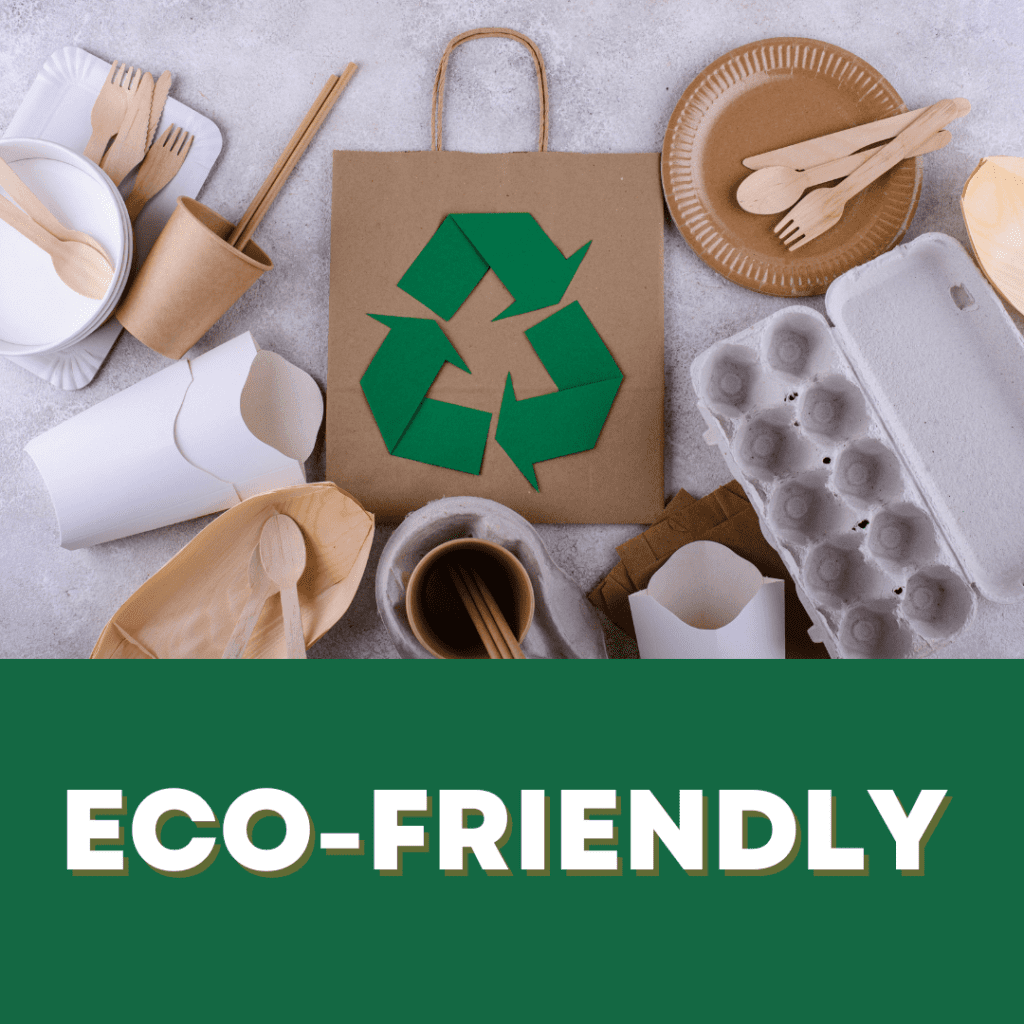As an Amazon Associate, I earn from qualifying purchases.
Hey there, ice cream aficionados and eco-conscious entrepreneurs! Ready to dive into the cool world of sustainable ice cream packaging? Well, grab your reusable spoon, and let’s get scooping!
But first, let me serve up a mind-melting statistic: Did you know that the global sustainable packaging market is projected to reach a whopping $470.3 billion by 2027?
That’s right, folks – we’re talking billions with a ‘B’! It seems like sustainability isn’t just a fleeting trend; it’s the future of packaging, and the ice cream industry is no exception.
Now, I know what you’re thinking: “But wait, isn’t keeping ice cream cold kind of… energy-intensive?” Well, you’re not wrong. But here’s the scoop: innovative eco-friendly solutions for ice cream packaging are hotter than ever (pun absolutely intended). So, let’s chill out and explore how you can make your ice cream business more sustainable in 2024!
The Scoop on Sustainable Materials

Alright, let’s start with the basics – the actual stuff your delicious frozen treats are packaged in. In 2024, we’re seeing some seriously cool (sorry, can’t help the puns) innovations in sustainable materials.
First up, we’ve got biodegradable options. PLA (Polylactic Acid) is leading the charge here. It’s made from renewable resources like corn starch or sugarcane, and it breaks down into natural components. Imagine telling your customers their empty ice cream container will basically turn into plant food. How’s that for guilt-free indulgence?
But PLA isn’t the only player in town. Bagasse, a byproduct of sugarcane processing, is making waves in the ice cream packaging world. It’s sturdy, it can handle freezing temperatures, and it’s 100% biodegradable. Plus, it gives sugarcane farmers an extra revenue stream. Talk about a win-win!
Now, let’s talk recyclables. Paper-based containers with special coatings are becoming increasingly popular. These bad boys can handle the cold and moisture of ice cream while still being recyclable. Just make sure to educate your customers on proper recycling practices – that coating needs to be handled correctly at recycling facilities.
But why stop at single-use? Reusable packaging is gaining traction in the ice cream world. Imagine selling your ice cream in durable, attractive containers that customers can bring back for refills. It’s like the Milkman model, but way cooler (last pun, I promise… maybe).
And for the ultimate in waste reduction, how about edible packaging? That’s right, some innovative companies are developing wafer-based containers that you can munch on after you’ve finished your ice cream. It’s like an ice cream cone but for your pint!
Lastly, let’s not forget about compostable materials. These are designed to break down in industrial composting facilities, turning your ice cream packaging into nutrient-rich soil. Just be sure to clearly label these as commercially compostable to avoid confusion.
Cool Designs for Hot Sustainability
Now that we’ve covered materials, let’s talk design. Because when it comes to sustainable packaging, it’s not just about what it’s made of – it’s about how it’s made.
Minimalist packaging is having a moment, and for good reason. By reducing the amount of material used, you’re automatically reducing waste. Plus, a sleek, simple design can really make your brand stand out on crowded freezer shelves.
Smart labeling is another trend to watch. We’re seeing QR codes that link to detailed recycling instructions, or color-coded systems that make it easy for consumers to sort their waste correctly. Remember, the easier you make it for your customers to recycle, the more likely they are to do it!
Innovative shapes are also making a splash in the sustainable packaging world. Think hexagonal containers that tessellate perfectly, reducing wasted space in shipping and storage. Or how about a container that flattens completely when empty, taking up less space in recycling bins?
Multi-functional packaging is another clever solution. Imagine a container that turns into a toy or a useful household item after the ice cream is gone. It’s not a waste if it’s still being used, right?
Lastly, we’re seeing some cool innovations in temperature-indicating designs. These can help reduce energy waste by showing consumers when their ice cream is at the perfect temperature to eat, preventing unnecessary freezer openings.
The Chill Factor: Insulation Solutions
Alright, let’s address the elephant in the room – keeping ice cream cold. It’s kind of important, you know? But traditional insulation methods aren’t always the most eco-friendly. So what’s a sustainable ice cream business to do?
Enter sustainable insulation materials. We’re talking recycled denim, sheep’s wool, and even mushroom-based insulation! These materials can provide excellent temperature control while being much kinder to the environment than traditional foam or plastic insulation.
But why stop at passive insulation? Innovative cooling technologies are emerging that could reduce or even eliminate the need for traditional freezers. Think of small, portable cooling units that activate when the ice cream reaches a certain temperature.
Vacuum-insulated containers are another cool solution (okay, I lied about the puns earlier). These work like a thermos, keeping your ice cream colder for longer without the need for external refrigeration.
Phase-change materials are also making waves in the ice cream world. These clever materials absorb or release heat at specific temperatures, helping to maintain a consistent temperature for your frozen treats.
And let’s not forget about good old-fashioned physics! Reflective coatings on packaging can help deflect heat, keeping your ice cream colder for longer. It’s like a tiny space blanket for your dessert!
Branding with a Conscience

Now, let’s talk about making your sustainable packaging work for your brand. Because let’s face it – doing good is great, but it’s even better when it helps your business too!
First up, consider using eco-friendly inks and dyes on your packaging. These are typically made from natural, non-toxic ingredients and can be just as vibrant as traditional inks.
Next, think about how you can incorporate sustainability into your brand story. Are you a beach-side ice cream shop using ocean-friendly packaging? Or maybe you’re partnering with local farmers to source sustainable packaging materials? Whatever your angle, make it part of your brand narrative.
Education is key when it comes to sustainable packaging. Use your packaging design to teach customers about proper recycling or composting practices. A little infographic can go a long way!
Collaborating with environmental organizations can also boost your sustainability cred. Whether it’s partnering with a local clean-up initiative or supporting global conservation efforts, these collaborations can strengthen your brand’s commitment to sustainability.
Lastly, be transparent about your sustainability efforts. Customers appreciate honesty, so don’t be afraid to share both your successes and your challenges in going green.
The Business Case for Sustainable Packaging
Now, I know what some of you might be thinking: “This all sounds great, but what about the bottom line?” Well, buckle up, because we’re about to talk business!
First, let’s address the elephant in the room – cost. Yes, sustainable packaging options can be more expensive upfront. But here’s the thing: they can lead to long-term savings. How? Think reduced waste management costs, potential tax incentives, and improved efficiency in your supply chain.
But the benefits go beyond just cost savings. Sustainable packaging can significantly boost customer loyalty and improve brand perception. In a world where consumers are increasingly eco-conscious, being a green brand can set you apart from the competition.
And speaking of setting yourself apart – sustainable packaging can be a great way to justify premium pricing. Many consumers are willing to pay more for products they perceive as environmentally friendly. It’s not just ice cream they’re buying; it’s peace of mind.
Let’s not forget about regulatory compliance. Environmental regulations are getting stricter every year. By adopting sustainable packaging now, you’re future-proofing your business against potential regulatory changes.
Lastly, sustainable packaging opens up a whole new world of marketing opportunities. From social media campaigns showcasing your eco-friendly initiatives to partnerships with environmental influencers, going green can give your marketing a serious boost.
Wrapping It Up (In a Biodegradable Bow, Of Course)
So there you have it, folks – the inside scoop on sustainable ice cream packaging in 2024. From biodegradable pints to edible spoons, the world of eco-friendly ice cream packaging is as diverse and exciting as the flavors you’re scooping up.
Remember, every sustainable choice is a step towards a cooler future for our planet. And a cooler is always better in the ice cream business, right?
So why not lead the charge in your industry? Your customers will love you for it, your conscience will thank you, and hey – Mother Earth might even send you a thank-you note (though it’ll probably be on recycled paper).
Now go forth and package sustainably, my frozen dessert friends! May your ice cream be delicious, your carbon footprint be small, and your business is booming. Here’s to a greener, sweeter future for us all!
Disclaimer: The information provided by IceCreamBusinessBoss.com (“The Site”) is for general informational purposes only. All information on the Site is provided in good faith, however, we make no representation or warranty of any kind, express or implied, regarding the accuracy, adequacy, validity, reliability, availability, or completeness of any information on the Site. Under no circumstance shall we have any liability to you for any loss or damage of any kind incurred as a result of the use of the Site or Reliance on any information provided on the Site. Your use of the Site and your reliance on any information on the Site is solely at your own risk. This blog post is for educational purposes only and does not constitute legal advice. Please consult a legal expert to address your specific needs. Terms and Conditions.

Hi! I am Shawn and I am a happy individual who happens to be an entrepreneur. I have owned several types of businesses in my life from a coffee shop to an import and export business to an online review business plus a few more and now I create online ice cream/gelato business resources for those interested in starting new ventures. It’s demanding work but I love it. I do it for those passionate about their business and their goals. That’s why when I meet a ice cream/gelato business owner, I see myself. I know how hard the struggle is to retain clients, find good employees and keep the business growing all while trying to stay competitive.
That’s why I created Ice Cream Business Boss: I want to help ice cream and gelato business owners like you build a thriving business that brings you endless joy and supports your ideal lifestyle.

